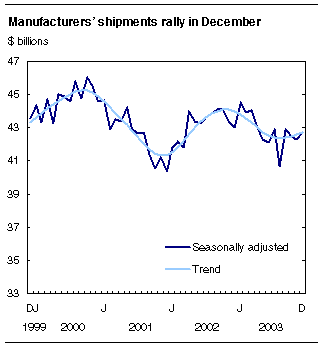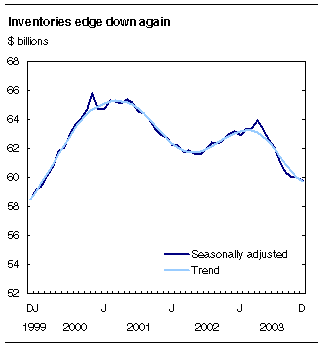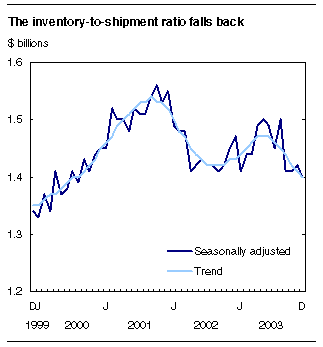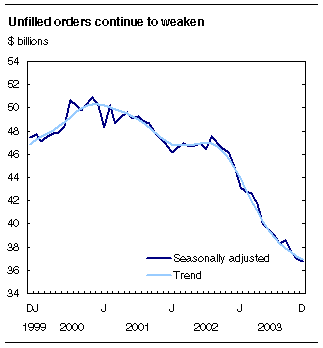
















 |
|
 |                |
Information identified as archived is provided for reference, research or recordkeeping purposes. It is not subject to the Government of Canada Web Standards and has not been altered or updated since it was archived. Please "contact us" to request a format other than those available.

|

Friday, February 13, 2004 Monthly Survey of ManufacturingDecember 2003 and Annual 2003A modest increase in December's shipments capped off what has otherwise been a bumpy ride for manufacturers in 2003. Shipments rose 1.0% to $42.7 billion, the first increase in three months. Meanwhile, manufacturers' prospects seem encouraging as they continue to sign new orders. Orders climbed 1.6% in December, the third boost in four months. Canada's manufacturers remain cautiously optimisticFollowing a lacklustre 2003, Canadian manufacturers were cautiously optimistic regarding the outlook for the first quarter of 2004. According to the Business Conditions Survey for January, business confidence improved and greater satisfaction was expressed for finished-product inventory levels and orders received, while 30% of manufacturers anticipated that they would increase production during the first quarter. However, there was some trepidation noted regarding the low levels of unfilled orders. On the job front, manufacturing employment rose by 4,800 positions in January, but remained well below levels of one year ago, according to the recent Labour Force Survey. Employment was largely unchanged in December (-1,900).
Most provinces and the territories post gains in DecemberOntario led the six provinces and the territories reporting higher shipments in December. Manufacturers posted shipments of $22.7 billion, up $325 million (+1.5%) in Ontario, wiping out November's 1.4% drop. The motor vehicle and chemical products industries were largely responsible. Shipments in Quebec rose by $52 million (+0.5%) to $9.8 billion, the highest level since September. Aerospace manufacturing and quarter-end boosts in the computer industry were the primary contributors. New Brunswick also reported a strong gain in December, as shipments increased for the second month in a row to $1.1 billion (+5.8%).
Production of big-ticket items boosts shipmentsBy industry, 15 of the 21 major groups, accounting for 64% of total shipments, reported increases in December. Manufacturers of big ticket, durable goods, including aircrafts, motor vehicles and parts, rose 1.2% to $24.2 billion, the first increase since September. Nondurable goods manufacturing edged up 0.7% to $18.5 billion. Leading all industries, motor vehicle shipments increased 3.0% to $5.0 billion in December, recovering somewhat from consecutive declines in October (-2.1%) and November (-4.1%). The trend for motor vehicle manufacturing has been gradually descending since mid-2002. Motor vehicle production has been quite volatile in 2003, as manufacturers and retailers attempted to grapple with market conditions. During the year, auto retailers continued to tempt consumers with generous incentives, while low interest rates provide affordable financing. Despite these factors, in recent months, temporary plant shutdowns and a deceleration in production by some manufacturers have been necessary for inventory control purposes. Gains reported in aerospace and chemicalsOther industries reporting higher shipments in December included aerospace, chemical products and motor vehicle parts. Production of aerospace products and parts jumped 13.0% to $920.6 million, regaining ground lost in November (-12.7%). Meanwhile, pharmaceutical manufacturers contributed to a 2.6% rise in shipments of chemical products to $3.3 billion, the highest level since September. The motor vehicle parts industry reported a 2.7% increase in December. 
Partly offsetting the rise in total shipments was the wood products industry, where shipments plunged 7.6% to $2.3 billion. This was the third consecutive decline, and was primarily due to a significant drop in the industrial price of wood and a labour dispute in British Columbia's coastal forestry sector. Manufacturers continue to clear out inventoriesIn December, inventories closed the year at $59.8 billion, down 0.3% from November. Manufacturers' inventories have been in a gradual decline since last spring, falling 6.4% since their recent high of $63.9 billion in April. Inventories of raw materials, which have been on a steady decline throughout 2003, were essentially unchanged at $25.9 billion in December, the lowest level in just over four years. Meanwhile, decreases were reported in both goods-in-process (-1.0%) and finished-product (-0.2%) inventories. Finished-products ($18.9 billion) continued their downward trek, and following eight consecutive declines, they are at the lowest level since August 2002. Decreases in inventories of aerospace products and parts (-1.7%) and primary metals (-1.2%) offset a 2.2% gain in the chemical products industry. 
The inventory-to-shipment ratio falls to a three-year lowImproved shipments coupled with a small reduction in inventories, contributed to a lower inventory-to-shipment ratio in December. The ratio fell to 1.40, the lowest level in over three years. Inventories have been trending down throughout the year. The finished-product inventory-to-shipment ratio also edged down to 0.44 in December from 0.45 in November. This ratio is a measure of the time that would be required in order to exhaust finished-products if shipments were to remain at their current level. 
Manufacturers satisfied with level of new ordersManufacturers of aerospace products, motor vehicles and computers were among several industries reporting higher new orders in December. New orders improved a healthy 1.6% to $42.4 billion, doubling November's gain (+0.8%). A sign of future production, new orders have risen in three of the last four months. Order cancellations contribute to further declines in unfilled ordersAlthough manufacturers were upbeat about the level of new orders received, the ongoing decrease in the backlog of unfilled orders remained a vulnerable component of the Canadian manufacturing sector. Contract cancellations and weaknesses in some industries contributed to a 0.8% drop in unfilled orders to $36.7 billion for December. Orders, currently at the lowest level since August 1997, have declined in 15 of the last 16 months. Heading into 2004, the continued erosion of unfilled orders remained a source of unease for manufacturers. January's Business Conditions Survey noted that 23% of manufacturers expressed concern for the lower-than-normal backlog of orders. Decreases in unfilled orders were widespread in December, including the transportation equipment (-0.9%), plastics and rubber products (-8.3%), and electrical equipment, appliance and component (-9.1%) industries. 
Canadian manufacturers faced a rough ride in 2003For the year as a whole, manufacturing shipments slipped 1.0% to $513.2 billion in 2003, following a gain of 1.9% in 2002. As well, by year's end, manufacturers' books were significantly lighter. Unfilled orders were just $36.7 billion in December, down 18% (-$8.1 billion) from December 2002 ($44.8 billion), and the lowest level in over six years. On the positive side, inventories are down substantially (-5.3%) since December 2002, and in recent months, orders booked by manufacturers have been on the rise. Shipments and orders abound in the United StatesIn contrast to Canada's slowdown in production, manufacturers south of the border muscled their way through 2003. US factory shipments increased 2.7% by year-end, as a steady stream of new orders were placed on manufacturers' books. Various factors hold back Canadian manufacturingTo recap, several negative events affected Canadian manufacturers and the economy as a whole in 2003. Most global economies were held at bay during the first part of the year, as the war in Iraq unfolded. The SARS virus devastated the service and tourism sectors of the Toronto region, while the single case of BSE (mad cow disease) in Alberta closed international borders to Canadian beef. Much of Canada's manufacturing heartland in Ontario was darkened by the electrical blackout of August 14. During the following week of energy conservation, many factories operated at reduced capacity. Meanwhile, fires consumed forests in British Columbia, and the Canada-US softwood lumber dispute trade remained in the courts of law. These events cut into what could have been a more prosperous year for the wood products industry, as North American demand for new housing boomed. In addition to all of these factors, the Canadian dollar closed the year at a 10-year high against its US counterpart. Autos and computers drive down shipmentsDespite incentive-laden deals and excellent financing options, motor vehicle manufacturers reported the largest decrease in shipments in 2003. Motor vehicle shipments slumped 5.0% to $62.5 billion, following a robust 2002 (+5.7%). Canada's telecommunications sector continued to struggle since the industry crashed in 2001. Shipments of computer and electronic products dropped 12.9% to $18.5 billion in 2003. Just three years ago, computer shipments peaked at $37.5 billion. In the latter half of 2003, there have been signs that the telecommunications sector may be starting to recover. Other notable decreases in 2003 included paper manufacturing (-4.4%), in part the result of falling prices, the machinery industry (-5.3%) and the aerospace products and parts industry (-8.4%). Higher industrial prices for petroleum and chemical products partly offset an otherwise dismal year for manufacturers. Prices of petroleum and coal products soared earlier in 2003, boosting shipments 10.4% to $35.7 billion overall. Strong demand and high prices for pharmaceutical and petrochemical products contributed to a 4.8% jump in chemical products manufacturing, over the same period in 2002. Manufacturing slows in Canada's largest provincesThe lacklustre performance of 2003 was concentrated in Canada's two largest manufacturing economies, Ontario and Quebec, in addition to British Columbia, and was only partly offset by improvements in the remaining provinces and the territories. Alberta led the majority of provinces reporting higher shipments for the year. Shipments weaken in Ontario and QuebecA marked slowdown in motor vehicle and parts manufacturing, coupled with the electrical blackout of August 14, contributed to Ontario's weak standing in 2003. A downturn in production of machinery, and the ongoing malaise of the computer industry also contributed. Total shipments in Ontario slipped 1.7% (-$4.7 billion) to $272.9 billion in 2003, following a 3.4% rise in 2002. Quebec's manufacturers posted shipments of $119.1 billion, a 2.4% (-$2.9 billion) drop from 2002. The downturn in the global aviation sector continued to batter Quebec's aerospace products and parts industry. Computer manufacturing also retrenched sharply following a steep decline in 2002. The clothing and textile mills industries reported significant decreases, partially because of the ongoing globalization of these industries. Wood products pull down shipments in British ColumbiaBritish Columbia rounded out the three provinces reporting lower shipments in 2003. Shipments decreased 2.4% to $33.4 billion (-$835 million), following a 0.4% rise in 2002. The prevailing export duties on softwood lumber, coupled with falling prices, contributed to a sharp drop in shipments of wood products. Fewer shipments of transportation equipment and computers also contributed. Alberta improves, leading all provincesFollowing a lacklustre 2002 (-3.4%), manufacturing shipments in Alberta rebounded 5.0% (+$2.1 billion) to $43.0 billion, leading all provinces reporting higher shipments. Despite the negative impact of mad cow disease on the Alberta economy, higher industrial prices partly contributed to the improvement in 2003. The petroleum, fabricated metal products and chemical products industries led Alberta's manufacturing sector in 2003. The wood products and chemical products industries contributed to a robust 2003 for Saskatchewan manufacturers. Total shipments were up 3.7% (+$265 million) to $7.5 billion, following a 1.3% increase in 2002. Manitoba's diversified manufacturing sector contributed to a relatively stable year. Shipments edged up 0.9% (+$101 million) to $11.6 billion. Increases in fabricated metal products and chemical manufacturing led all industries. Atlantic Canada posts strong gainsFor the second consecutive year, the Atlantic Provinces reported increases in manufacturing activity. Led by a 3.4% (+$428 million) jump in New Brunswick, shipments ended the year at $13.1 billion. Meanwhile, manufacturing in Nova Scotia improved 1.8% (+$155 million) to $8.8 billion, while Newfoundland and Labrador reported a healthy gain of 6.8% (+$151 million) to $2.4 billon. Prince Edward Island manufacturers posted shipments of $1.3 billion, up 1.2% (+$16 million) in 2003. This is well off the province's gain of 9.5% last year. Available on CANSIM: tables 304-0014 and 304-0015. Definitions, data sources and methods: survey number 2101. The December 2003 issue of the Monthly Survey of Manufacturing (31-001-XIE, $17/$158) will be available soon. Data for shipments by province in greater detail than normally published may be available on request. All data are benchmarked to the 1998 Annual Survey of Manufactures. Data from the January 2004 Monthly Survey of Manufacturing will be released on March 16. For general information or to order data, contact the dissemination officer (1-866-873-8789; 613-951-9497; fax: 613-951-9499; manufact@statcan.gc.ca). To enquire about the concepts, methods or data quality of the release, contact Russell Kowaluk (613-951-0600; kowarus@statcan.gc.ca), Manufacturing, Construction and Energy Division.
| ||||||||||||||||||||||||||||||||||||||||||||||||||||||||||||||||||||||||||||||||||||||||||||||||||||||||||||||||||||||||||||||||||||||||||||||||||||||||||||||||||||||||||||||||||||||||||||||||||||||||||||||||||||||||||||||||||||||||||||||||||||||||||||||||||||||||||||||||||||||||||||||||||||||||||||||||||||||||||||||||||||||||||||||||||||||||||||||||||||||||||||||||||||||||||||||||
|
|
|